 The side of the moon that always faces Earth
The side of the moon that always faces Earth
For many centuries, Man had dreamed of flying to the Moon.
Locations of six Apollo flights to the moon with mission numbers
And then, suddenly, as it seemed, by 1972 six flights had been made to Earth's sole satellite. This is the story of one of them.
Apollo 15 on its Launch Pad
On July 6, 1971, NASA launched one of the most ambitious and spectacular space missions in history - Apollo 15.
Apollo
15 Rocket Launch
At 12.34 GMT, the giant Saturn 5 rocket lifted off from Launch Complex 39A at Kennedy Space Centre in Florida.

It carried Commander Dave Scott, Command Module Pilot Al Worden, and Lunar Module Pilot Jim Irwin into an orbit circling the Earth.
Full moon over Earth viewed from the International Space Station
About three hours after the launch, engines were reignited for the journey to the Moon.
The Apollo space craft leaves Earth orbit for the Moon.
Turning 180° in Space
After setting a course for the Moon, the four adapter plates on the sides of the spacecraft were ejected, releasing the Command and Service Module Endeavour. Al Worden manoeuvred the spacecraft around 180° and nudged it into contact with the Lunar Module Falcon, which was nested inside the third stage of the rocket.
The Command and Service Module Endeavour
Extraction of Falcon
After making contact and latching the two spacecraft together, Endeavour then extracted Falcon from the hollow upper stage of the rocket,
Command and Service Module Endeavour
and the combined spacecraft was on its way to the Moon.
The spacecraft passed about 110 km behind the Moon, and the Service Module engine was fired to slow the spacecraft down and place Apollo 15 into an elliptical lunar orbit .
Earlier Moon Landings
Apollo 11: Astronaut Buzz Aldrin walks on the surface of the Moon.
A post about landing on the Moon should begin with an image of Neil Armstrong, who was the first man to set foot there, but, strangely enough, no decent photos exist of his doing so. Apparently, he shunned the limelight, leaving the prestige to Lunar Module Pilot, Buzz Aldrin. On stepping down onto the surface, Neil's first words were recorded as: "That's one small step for Man, and a giant leap for Mankind". But that doesn't make a lot of sense. Controversy has raged ever since about that missing 'a'.
Close-up of Aldrin’s face mask
Neil Armstrong took the photo, and his image as well as Aldrin’s shadow can be clearly seen in it.
The first photograph taken on the Moon by Neil Armstrong featured a trash bag. Scientists estimate that Mankind has left over 413,000 pounds of material on the Moon. That colossal junk heap includes three moon buggies.
Another much smaller peace of junk left just lying on the lunar surface is a plaque claiming it was planted there by 'men from earth', (obviously) insisting that they came 'in peace' (although there was nobody there to fight any war with). One is bound to wonder whether this is an unconscious allusion to the American war in Vietnam that was still raging after 14 years. The claim that they came ‘for all mankind’ was manifestly false. Their naked purpose was to outstrip the Soviet Union, with whom they had refused to cooperate in a joint lunar venture.
Apollo 12 on Launch Pad
Apollo 12 was the sixth crewed flight in the Apollo program and the second to land on the Moon. Apollo 12's spacecraft and launch vehicle were almost identical to Apollo 11's. One addition was hammocks to allow the landing crew to rest more comfortably on the Moon. On November 19, Charles Conrad and Alan Bean achieved a precise landing at their expected location within walking distance of the Surveyor 3 robotic probe, which had landed on April 20, 1967.
Surveyor 3 Robotic Probe
On the second of two moonwalks, they visited Surveyor 3 and removed parts for return to Earth.
Apollo 13 Command Module on board U.S.S. Iwo Jima
Apollo 13 was the seventh crewed mission in the Apollo space program and the third meant to land on the Moon. The craft was launched from Kennedy Space Centre on April 11, 1970, but the lunar landing was aborted after an oxygen tank in the service module (SM) failed two days into the mission. The crew instead looped around the Moon and returned safely to Earth on April 17.
Edgar Mitchell, Lunar Module Pilot leaving the Command Module after splashdown.
Apollo 14 was the eighth crewed mission in the Apollo program, the third to land on the Moon, and the first to land in the lunar highlands. During the two walks the two astronauts, Alan Shepard and Stuart Roosa roamed the surface, collecting 42 kg of Moon rocks and deployed several scientific experiments.
The Lunar Rover
Apollo 15 was a leap forward in the Moon landing program. Previous missions had been limited to two days on the Moon, during which the astronauts were able to walk only short distances from their Lunar Modules. Now, they could remain for three days on the Moon and range much further afield by means of an effective Lunar Rover.
In David Scott's opinion, the decision to land Apollo 15 at Hadley was perfect, since Hadley had more variety than did the alternatives. "There is", he said, "a certain intangible quality which drives the spirit of exploration and I felt that Hadley had it. Besides, it looked beautiful and usually when things look good they are good."
Alan Shephard
That assertion caused Alan Shepard, the Apollo 14 commander, who was awaiting a television interview, to grumble, "To hell with that shit, give us details of the burn."
He was referring to a planned engine firing on the far side of the moon when Apollo 15 was out of contact with the Earth.
The exact spot where Apollo 15 landed is marked in red. If you look closely, you can see Hadley Rille (Rima Hadley), one of the many winding cracks on the surface of the moon. They are thought to belong to the Moon’s primal crust.
 The
Apollo 15 landing site viewed from the opposite side.
The
Apollo 15 landing site viewed from the opposite side.
I would assume that the crater in the middle of the photo is Archimedes.
Now, if Americans first came to the moon, as claimed on the sign they left there at the end of their first mission, ‘for all mankind’ then why did they, on every single mission, plant an American flag there and salute it? Why did every moon mission have to be sanctified by an act of chauvinism?
 The
United Nations Flag
The
United Nations Flag
Surely, it would have been more appropriate to plant the flag of the United Nations there. Anyway, every one of these emblems of vanity left on the Moon will have faded into indistinctness by now, adding to the estimated 400,000 pounds of human trash left on our closest earthly neighbour.
The mission began when Command Module Pilot, David Scott, and Lunar Module Pilot, James Irwin, landed near Hadley Rille and explored the local area using the rover, allowing them to travel further from the Lunar Module than had been possible on previous missions.
Dave Scott drilling in the lunar soil
This is a panoramic shot which includes Dave Scott crouching over a drill used to take core samples of the lunar surface.
A photo showing the Earth over the Moon.
Testing the Lunar Rover
David Scott tests the steering mechanisms of the Lunar Rover before the second session of extra vehicular activity.
James Irwin with the Lunar Rover
James
Irwin works at the Lunar Rover Vehicle during the first Apollo 15
moonwalk. Mount Hadley, 4,500 m, is in the background.
James Irwin explores the landscape near Hadley Rille
Astronauts
Irwin and Scott performed 18.5 hours of extra vehicular activity on
the Moon's surface using the rover, and collected 370 individual
rocks and soil samples during their exploration.
 Command Module Piolet Al Worden in Training
Command Module Piolet Al Worden in Training
Meanwhile, Al Worden circled the Moon 34 times in the Command Module. In the photo, he is training for his role at Cape Canaveral, Florida.
 “Falcon”
on the Plain at Hadley
“Falcon”
on the Plain at Hadley
Exploration
of the lunar surface at Hadley. Mission Commander David Scott and
the Lunar Rover can be seen in the distance.
Photo pinpointing the location of Hadley Rille and the Lunar Module with the Lunar Rover 5km away.
"The Apollo 15 landing site with rover tracks, astronaut footprints and equipment will be much the same today as when the crew departed in July 1971", some hack wrote obliviously. But it will not at all be the same as it was before the astronauts arrived!
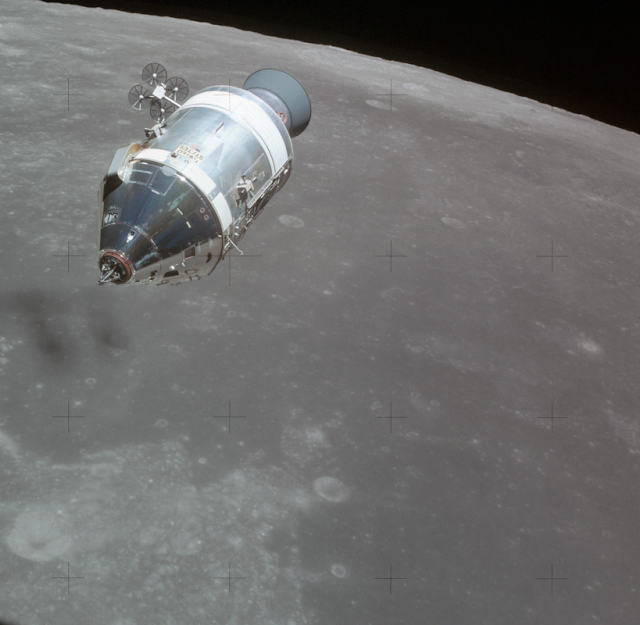 Lunar
Module "Falcon", seen from "Endeavour"
Lunar
Module "Falcon", seen from "Endeavour"
Meanwhile,
during the near three-day exploration of Hadley, the Apollo 15
command and service module "Endeavour", piloted by Al
Worden, circled the moon 34 times.
 One
of the Apollo 15 postal covers
One
of the Apollo 15 postal covers
Apollo
15 accomplished its goals but was marred by negative publicity the
following year when it emerged that the crew had carried unauthorized
postal covers to the lunar surface.
The Crew of Apollo 15
They had intended to sell them to earn money reputedly for their children's education, but they were reprimanded for poor judgment, and did not fly in space again.
 Lunar
Module ascent stage "Falcon"
Lunar
Module ascent stage "Falcon"
The Lunar Module ascent stage is photographed from the Command
and Service Module (CSM) during rendezvous in lunar orbit. The Lunar
Module (LM) was making its docking approach to the CSM.
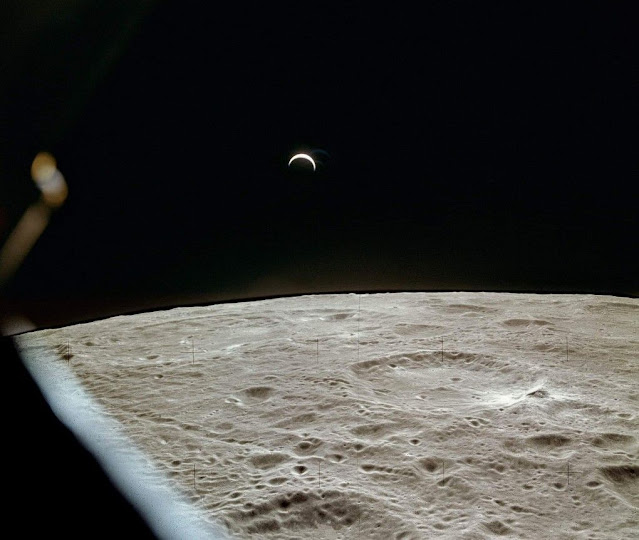 Earthrise
over Lunar Surface
Earthrise
over Lunar Surface
Craters
Gibbs and Schorr are visible from the Apollo 15 command module.
Al Worden's Extravehicular Activity (EVA)
On
the second day of the return journey to Earth, Al Worden performed a 39-minute
EVA to retrieve film cassettes from the service module's scientific
instrument module (SIM) bay. He was the first man ever to perform
a task in deep space.
 View
of Earth from Apollo 15
View
of Earth from Apollo 15
 The
Command Module by David Teixidor
The
Command Module by David Teixidor
An artist’s impression of the Command Module with the three astronauts seated inside it.
 Apollo
15 Descent to Earth
Apollo
15 Descent to Earth
With one of its three parachutes failing to open, the Apollo 15 Command Module is about to splash down into the Pacific Ocean.
 Apollo
15 Splashes into the Pacific Ocean
Apollo
15 Splashes into the Pacific Ocean
 Retrieval
of Apollo 15 and Its Crew
Retrieval
of Apollo 15 and Its Crew
The Apollo 15 astronauts and their Command Module were retrieved from the sea by frogmen of the U.S.S. Okinawa on August 7, 1971
Hoisting
of the
Command Module
Apollo 15 Recovery frogmen prepare to hoist the Command Module aboard the U.S.S. Okinawa.
 Apollo
15 Command Module
Apollo
15 Command Module
The Apollo 15 Command Module had suffered a little disintegration in its plunge to Earth, but now it suffers the ignominy of being a mere museum piece.
Who knows how long the Apollo program would have gone on if the public had been willing to finance it?
But they were not. All the razzmatazz had gone out of it, and the 1970s oil crisis was looming.
 1935
Film: Dancing On The Moon
1935
Film: Dancing On The Moon
NASA brought its moon fantasy program to an end with two last moon shots.
Charles Duke during a moonwalk
Apollo 16 astronaut Charles Duke standing on the rim of Plum crater, which is 40 meters in diameter and about 10 meters deep.
 Picture
from a Nitwit
Picture
from a Nitwit
Others have left their trash on the moon but this idiot has absolutely trivialised the whole affair with his particular piece of trash: a family photo! It seems that the story of the American moon landings began in drama and ended in farce.
Eugene Cernan
Apollo 17: Eugene Cernan was the last man to walk upon the moon.
 The side of the moon that always faces Earth
The side of the moon that always faces Earth








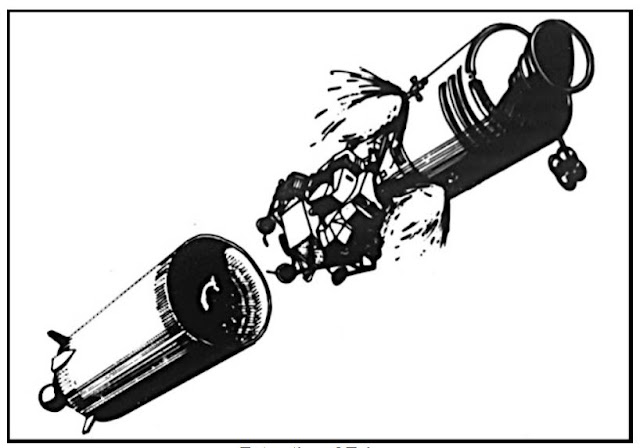




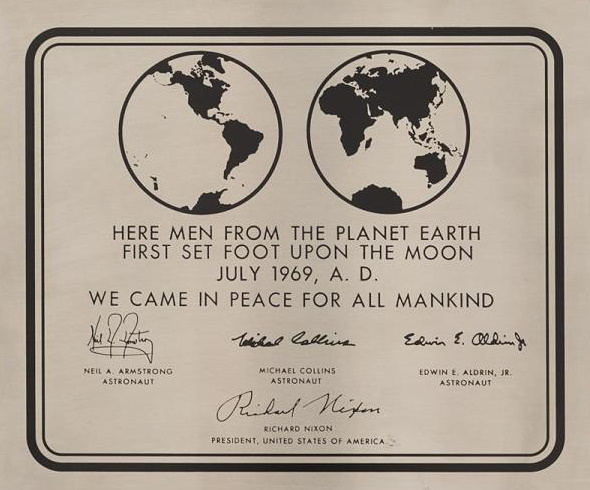

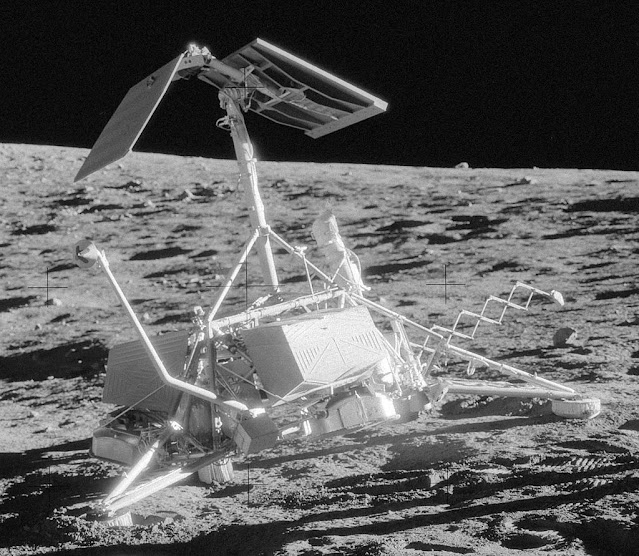



%20labelled.png)



































No comments:
Post a Comment